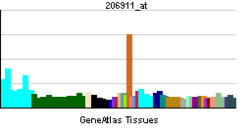TRIM25
Tripartite motif-containing protein 25 is a protein that in humans is encoded by the TRIM25 gene.[1][2]
The protein encoded by this gene is a member of the tripartite motif (TRIM) family grouping more than 70 TRIMs. The TRIM motif has 3 N-terminal domains which are a RING domain, a B-box type 1 and a B-box type 2, and a coiled-coil domain (CCD) and a C-terminal domain (SPRY). The protein localizes to the cytoplasm. The presence of potential DNA-binding and dimerization-transactivation domains suggests that this protein may act as a transcription factor, similar to several other members of the TRIM family. Expression of the gene is upregulated in response to estrogen, and it is thought to mediate estrogen actions in breast cancer as a primary response gene.[2]
TRIM25 functions
TRIM25 act in expression of IFN response. It interact with RIG-I which is a receptor from PRR (Pattern Recognitiion Receptor) family. Two domains of TRIM25 (RING and SPRY) allow an interaction with RIG-I. Thanks to this interaction an ubiquitination of RIG-I by TRIM25 is possible. Its follows an IFN production by an intracellular signaling pathway involving IRF3.
Viral escape
To avoid IFN production, a viral non structural protein (NS1) will interact with CCD domain of TRIM25 to block RIG-I ubiquitination. This CCD domain is essential for the binding of NS1 on TRIM25. Some studies have shown that with a deletion of the CCD domain the binding of NS1 was impossible.[3] Without this ubiquitination, there won’t be IFN production.
References
- ↑ Inoue S, Orimo A, Matsuda Y, Inazawa J, Emi M, Nakamura Y, Hori T, Muramatsu M (Jul 1995). "Chromosome mapping of human (ZNF147) and mouse genes for estrogen-responsive finger protein (efp), a member of the RING finger family". Genomics 25 (2): 581–3. doi:10.1016/0888-7543(95)80064-S. PMID 7789997.
- ↑ 2.0 2.1 "Entrez Gene: TRIM25 tripartite motif-containing 25".
- ↑ Gack, Michaela Ulrike, Randy Allen Albrecht, Tomohiko Urano, Kyung-Soo Inn, I.-Chueh Huang, Elena Carnero, Michael Farzan, Satoshi Inoue, Jae Ung Jung, et Adolfo García-Sastre. 2009. « Influenza A Virus NS1 Targets the Ubiquitin Ligase TRIM25 to Evade Recognition by the Host Viral RNA Sensor RIG-I ». Cell Host & Microbe 5 (5): 439‑49. doi:10.1016/j.chom.2009.04.006.
Further reading
- Horie K, Urano T, Ikeda K, Inoue S (2003). "Estrogen-responsive RING finger protein controls breast cancer growth". J. Steroid Biochem. Mol. Biol. 85 (2–5): 101–4. doi:10.1016/S0960-0760(03)00209-7. PMID 12943693.
- Inoue S; Orimo A; Hosoi T et al. (1994). "Genomic binding-site cloning reveals an estrogen-responsive gene that encodes a RING finger protein". Proc. Natl. Acad. Sci. U.S.A. 90 (23): 11117–21. doi:10.1073/pnas.90.23.11117. PMC 47933. PMID 8248217.
- Bonaldo MF, Lennon G, Soares MB (1997). "Normalization and subtraction: two approaches to facilitate gene discovery". Genome Res. 6 (9): 791–806. doi:10.1101/gr.6.9.791. PMID 8889548.
- Ikeda K; Inoue S; Orimo A et al. (1997). "Multiple regulatory elements and binding proteins of the 5'-flanking region of the human estrogen-responsive finger protein (efp) gene". Biochem. Biophys. Res. Commun. 236 (3): 765–71. doi:10.1006/bbrc.1997.7046. PMID 9245730.
- Ikeda K; Orimo A; Higashi Y et al. (2000). "Efp as a primary estrogen-responsive gene in human breast cancer". FEBS Lett. 472 (1): 9–13. doi:10.1016/S0014-5793(00)01421-6. PMID 10781795.
- Reymond A; Meroni G; Fantozzi A et al. (2001). "The tripartite motif family identifies cell compartments". EMBO J. 20 (9): 2140–51. doi:10.1093/emboj/20.9.2140. PMC 125245. PMID 11331580.
- Urano T; Saito T; Tsukui T et al. (2002). "Efp targets 14-3-3 sigma for proteolysis and promotes breast tumour growth". Nature 417 (6891): 871–5. doi:10.1038/nature00826. PMID 12075357.
- Strausberg RL; Feingold EA; Grouse LH et al. (2003). "Generation and initial analysis of more than 15,000 full-length human and mouse cDNA sequences". Proc. Natl. Acad. Sci. U.S.A. 99 (26): 16899–903. doi:10.1073/pnas.242603899. PMC 139241. PMID 12477932.
- Shimada N; Suzuki T; Inoue S et al. (2004). "Systemic distribution of estrogen-responsive finger protein (Efp) in human tissues". Mol. Cell. Endocrinol. 218 (1–2): 147–53. doi:10.1016/j.mce.2003.12.008. PMID 15130519.
- Gerhard DS; Wagner L; Feingold EA et al. (2004). "The Status, Quality, and Expansion of the NIH Full-Length cDNA Project: The Mammalian Gene Collection (MGC)". Genome Res. 14 (10B): 2121–7. doi:10.1101/gr.2596504. PMC 528928. PMID 15489334.
- Rush J; Moritz A; Lee KA et al. (2005). "Immunoaffinity profiling of tyrosine phosphorylation in cancer cells". Nat. Biotechnol. 23 (1): 94–101. doi:10.1038/nbt1046. PMID 15592455.
- Suzuki T; Urano T; Tsukui T et al. (2005). "Estrogen-responsive finger protein as a new potential biomarker for breast cancer". Clin. Cancer Res. 11 (17): 6148–54. doi:10.1158/1078-0432.CCR-05-0040. PMID 16144914.
- Rual JF; Venkatesan K; Hao T et al. (2005). "Towards a proteome-scale map of the human protein-protein interaction network". Nature 437 (7062): 1173–8. doi:10.1038/nature04209. PMID 16189514.
- Nakayama H; Sano T; Motegi A et al. (2005). "Increasing 14-3-3 sigma expression with declining estrogen receptor alpha and estrogen-responsive finger protein expression defines malignant progression of endometrial carcinoma". Pathol. Int. 55 (11): 707–15. doi:10.1111/j.1440-1827.2005.01900.x. PMID 16271083.
- Nakasato N; Ikeda K; Urano T et al. (2007). "A ubiquitin E3 ligase Efp is up-regulated by interferons and conjugated with ISG15". Biochem. Biophys. Res. Commun. 351 (2): 540–6. doi:10.1016/j.bbrc.2006.10.061. PMID 17069755.
- Nakajima A; Maruyama S; Bohgaki M et al. (2007). "Ligand-dependent transcription of estrogen receptor alpha is mediated by the ubiquitin ligase EFP". Biochem. Biophys. Res. Commun. 357 (1): 245–51. doi:10.1016/j.bbrc.2007.03.134. PMID 17418098.
